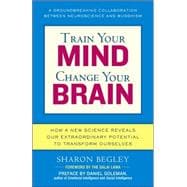
Note: Supplemental materials are not guaranteed with Rental or Used book purchases.
Purchase Benefits
Looking to rent a book? Rent Train Your Mind, Change Your Brain [ISBN: 9780345479891] for the semester, quarter, and short term or search our site for other textbooks by BEGLEY, SHARON. Renting a textbook can save you up to 90% from the cost of buying.
| Foreword | p. vii |
| Preface | p. xi |
| Acknowledgments | p. xv |
| I Can We Change?: Challenging the Dogma of the Hardwired Brain | p. 3 |
| The Enchanted Loom: The Discovery of Neuroplaslicity | p. 26 |
| New Neurons for Old Brains: Neurogenesis | p. 49 |
| A Child Shall Lead Them: The Neuroplasticity of Young Brains | p. 73 |
| Footprints on the Brain: Sensory Experience Reshapes Adult Brains | p. 110 |
| Mind over Matter: Mental Activity Changes the Brain | p. 131 |
| Nature through Nurture: Turning On Genes in the Brain | p. 161 |
| Blaming Mom?: Rewired for Compassion | p. 183 |
| Transforming the Emotional Mind: Challenging the Happiness "Set Point" | p. 212 |
| Now What? | p. 243 |
| Appendix | p. 255 |
| Notes | p. 263 |
| Index | p. 277 |
| Table of Contents provided by Ingram. All Rights Reserved. |
The New copy of this book will include any supplemental materials advertised. Please check the title of the book to determine if it should include any access cards, study guides, lab manuals, CDs, etc.
The Used, Rental and eBook copies of this book are not guaranteed to include any supplemental materials. Typically, only the book itself is included. This is true even if the title states it includes any access cards, study guides, lab manuals, CDs, etc.
Excerpted from Train Your Mind, Change Your Brain: How a New Science Reveals Our Extraordinary Potential to Transform Ourselves by Sharon Begley
All rights reserved by the original copyright owners. Excerpts are provided for display purposes only and may not be reproduced, reprinted or distributed without the written permission of the publisher.